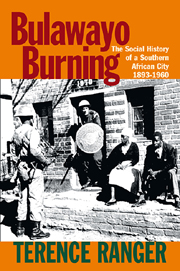Book contents
- Frontmatter
- Contents
- List of Illustrations
- Introduction
- Prelude: Bulawayo, 1893–1930
- 1 The Landscapes of Bulawayo
- 2 The First Fires: December 1929
- 3 City versus State 1930–1946
- 4 Mr Black Bulawayo 1930–1948
- 5 The Feminization of Black Bulawayo 1948–1960
- 6 Black Bulawayo Transformed
- 7 Black Bulawayo Burns 1960
- Postlude: Bulawayo after 1960
- Selected Bibliography
- Index
6 - Black Bulawayo Transformed
Published online by Cambridge University Press: 05 April 2013
- Frontmatter
- Contents
- List of Illustrations
- Introduction
- Prelude: Bulawayo, 1893–1930
- 1 The Landscapes of Bulawayo
- 2 The First Fires: December 1929
- 3 City versus State 1930–1946
- 4 Mr Black Bulawayo 1930–1948
- 5 The Feminization of Black Bulawayo 1948–1960
- 6 Black Bulawayo Transformed
- 7 Black Bulawayo Burns 1960
- Postlude: Bulawayo after 1960
- Selected Bibliography
- Index
Summary
Ashton's Bulawayo
Ashton's fine, fatherly qualities had not always been appreciated. In fact he made a disastrous start in Makokoba. In February 1950 he called a meeting in the township to discuss an increase in rents. A thousand people turned up. Sipambaniso, still at that point on the Advisory Board, was there. So was Burombo. According to the CID report, the audience introduced ‘irrelevant subjects’. Ashton lost control of the meeting, so Burombo took it over and ‘at one stroke, achieved the pedestal of popularity and gave a fillip to the Voice Association’. The main demand of the crowd was for tenancy – they should themselves be the tenants and be reimbursed by their employers. If such a change did not place, thought the CID, ‘Burombo will have another issue to contest for his “people's good”, and one that would affect many in the location’.
Nor were Burombo's African opponents more helpful or sympathetic to Ashton. Charlton Ngcebetsha's Home News began in 1953 by glorying in Burombo's humiliation at an attempted mass meeting of the British Voice Association in Stanley Square, ‘thanks to the educated “boys” of the Southern Rhodesia Federation of African Workers Unions’. In December 1953 it gleefully reported Burombo's expulsion from the Advisory Board for absenteeism. But in the same issue Ngcebetsha complained that Ashton and the Council treated the Advisory Board like a rubber stamp. ‘Location rents were raised in the teeth of opposition by all the members of the Advisory Board’. He demanded direct representation in the African Affairs Department. These were Ngcebetsha's radical years. He excoriated Prime Minister Garfield Todd.
- Type
- Chapter
- Information
- Bulawayo BurningThe Social History of a Southern African City, 1893–1960, pp. 185 - 216Publisher: Boydell & BrewerPrint publication year: 2010



